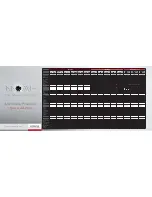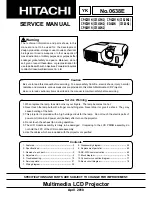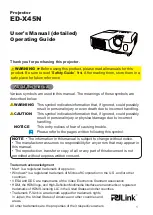
GLOSSARY
VistaPro 2000 User's Manual
A-5
A video output format of some video tape and disk players (used primarily in
France). SECAM (Sequential Couleur á Mémoire) signals are similar in
resolution and frequency to PAL signals. The primary difference between the
two standards is in the way color information is encoded.
A slidebar is a graphical display of an adjustable setting. The numerical setting
usually represents a percentage.
The device, such as a computer or VCR, connected to the projector for display.
A source is identified as
,
,
or
, or as other user-defined
numbers. Sources have corresponding source setups recognized by the projector.
A number from 1 to 99 that uniquely identifies a specific source.
A collection of measurements stored by the projector for a given source and/or
projector, including frequencies, pulse width, polarity, syncs, source number and
location, user-adjustable display settings, etc. Source setups enable the projector
to automatically recognize and properly display input from a variety of sources.
The diameter of the smallest dot that can be generated by a CRT projector.
VistaPro 2000 has a fixed spot (pixel) size.
A signal selector that can be connected to a projector for the purpose of adding
more sources.
This term refers to the part of the video signal that is used to stabilize the picture.
Sync can occur in three forms:
1)
"Composite sync": the horizontal and vertical components are together on
one cable.
2)
"Sync-on-green": the sync is part of the green video.
3)
"Separate sync" or "H.SYNC and V.SYNC": the horizontal and vertical
components of the sync are on two separate cables.
The duration of each sync pulse generated by a computer. The sync width is part
of the blanking time.
A type of RGB video with digital characteristics.
A wire connecting a single video source to a display device, such as a projector,
must be terminated by a resistance (usually 75
S for video).
The distance between the front feet of the projector and the screen. Also called
"Projector-to-Screen Distance”.
Balance of red-to-green necessary for realistic representation of NTSC signals.
The ability of a projector to synchronize to inputs with frequencies within a
specified range.
The frequency at which images are generated. Vertical frequencies vary amongst
sources. Also called vertical scan rate.
SECAM
'
Slidebar
'
Source
'
Source Number
'
Source Setup
'
Spot Size
'
Switcher
'
Sync
'
Sync Width
'
TTL Video
'
Terminated
'
Throw Distance
'
Tint
'
Variable Scan
'
Vertical Frequency
'














































